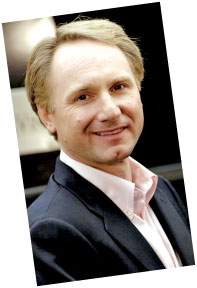|
Brown dabbles with noetic science in Lost Symbol :
Exploring new fontiers
by Indunil Thenuwara
Dan Brown, or to be more precise
Dan Brown’s novels, have introduced us to many ideas and sectors which
had hitherto been hidden from our view. In Deception Point he introduced
us to the marvels and mysteries of the Mariana Trench; in Digital
Fortress he opened our eyes to cryptography; in The Da Vinci Code he
introduced us to mysteries and concepts which are too numerous to even
mention.
 In his latest bestseller The Lost Symbol, Brown introduces us to
noetic science which had been, till now, an unfamiliar area of science
to most of us. Brown has the reputation of featuring strong female
characters in all his novels, and The Lost Symbol is no exception; its
leading lady, Katherine Solomon, is a noetic scientist. In his latest bestseller The Lost Symbol, Brown introduces us to
noetic science which had been, till now, an unfamiliar area of science
to most of us. Brown has the reputation of featuring strong female
characters in all his novels, and The Lost Symbol is no exception; its
leading lady, Katherine Solomon, is a noetic scientist.
For the uninitiated, noetic science is a science of the human mind,
the study of mental phenomena, which is broader than psychology as we
know it. In scientific parlance, it’s a branch of metaphysical
philosophy which studies the mind and intuition and their relationship
with the divine intellect. It could also be described as the study of
non-rational ways of knowing something and how they relate to reason and
relationships between humans and divine intervention.
Where did this particular branch of science spring from? Although
it’s not entirely new, it’s somewhat different from ‘normal science’.
The word noetic is believed to have originated from the Greek word ‘nous’,
which, though lacking an equivalent in English, means inner knowing, a
kind of intuitive consciousness or feeling; in other words direct and
immediate access to knowledge beyond what’s available to the normal
human senses and the power of reason. It encompasses the exploration of
the inner cosmos of the mind (consciousness, soul and spirit) and how it
relates to the outer cosmos of the physical world.
The noetic theory in Western traditions and Arab philosophy had been
strongly influenced by theories of prominent philosophers of the day
such as Anaxagoras, Plato and Aristotle.
The Institute of Noetic Sciences (IONS), mentioned in Brown’s novel,
does exist and conducts research into areas such as spontaneous
remission, meditation, consciousness, alternate healing, spirituality,
human potential, psychic abilities and the survival of consciousness
after death.
 The Institute was co-founded in 1973 by former astronaut Edgar
Mitchell, who was part of the Apollo 14 mission, industrialist Paul N.
Temple and others to conduct and encourage research on human potentials.
It’s headquartered in California and has research laboratories and
retreat centres where parapsychology studies are conducted in spheres
such as extra sensory perception, lucid dreams and presentiment. The Institute was co-founded in 1973 by former astronaut Edgar
Mitchell, who was part of the Apollo 14 mission, industrialist Paul N.
Temple and others to conduct and encourage research on human potentials.
It’s headquartered in California and has research laboratories and
retreat centres where parapsychology studies are conducted in spheres
such as extra sensory perception, lucid dreams and presentiment.
The non-profit organization examines phenomena ignored by mainstream
science and conducts and sponsors research into the potential and power
of consciousness.
So, if reading The Lost Symbol stirred a desire in you to learn more
about noetic science, you can certainly start doing so. Who knows? You
might become Sri Lanka’s first noetic scientist! |

